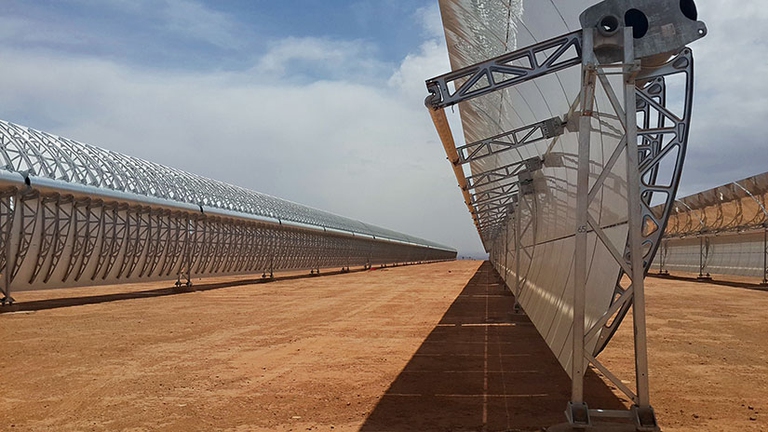
A group of experts in Tokyo suggested pouring radioactive water from Fukushima into the open sea. A marine biochemist explains the consequences of this absurd decision.
Lo confermano i progetti in Paesi come il Marocco, gli studi pubblicati su riviste scientifiche, le proiezioni dell’Agenzia internazionale dell’energia. È boom per il solare e per le rinnovabili.
More than one fourth (26%) of the world’s energy will be produced from renewable sources by 2020, as revealed by the latest report of the IEA (International Energy Agency). The report shows that in 2014 alone 22% of the total energy used worldwide was generated from renewable sources, such as solar, wind, and hydroelectric power.
It is an exponential growth, made possible thanks to investments in the sector, the reduction of costs of technologies, and investments made by developing countries. One example is Morocco, which will be home to one of the world’s largest concentration PV power plants, able to produce 580 MW of electricity, i.e. one third of the energy need of the Northern African country.
The solar power has registered a boom, as confirmed by the study “The great solar boom: a global perspective into the far reaching impact of an unexpected energy revolution”, published by Energy Science and Engineering. “The study shows how solar power is a perfect alternative able to carry out a great energy shift, which allows combining global economic growth and environmental protection, whilst coping with possible oil lacks, the increase in hydrocarbon extraction costs and population growth,” said Francesco Meneguzzo, study author and researcher at Ibimet NCR of Florence.
Solar power alone is worth 200 GW, amount enough to meet Italy’s energy demand, the study shows. “Solar power is worthwhile because, depending on the materials used, returns 10 to 50 times the energy used in its construction. Moreover, widespread uncertainties on land occupation seem to be outdated, since a surface smaller than 0.6% of the European territory would be enough to guarantee a complete PV coverage of the European Union’s electricity need”.
It’s a matter of costs, of course. “The increasing availability of electricity obtained from sun during peak hours caused a drop in the cost of the kWh in countries like Germany (from 51 euros/MWh in 2006 to 33 euros/MWh in 2014) and Italy (from 75 euros/MWh in 2006 to 52 euros/MWh in 2014),” explains Mario Pagliaro of the OSMN CNR of Palermo.
And there’s more. According to Greenpeace’s report “Energy Revolution 2015 – 100% renewable energy”, by 2050 we will be able to meet the entire global energy demand through renewables, thanks to investments that will be fully paid off by abandoning fossil fuels, in terms of economic and environmental benefits. “For a 100% renewable future by 2050, the average added investment in renewables would amount to 1 trillion dollars per year. Because renewable energy has no fuel costs, the cost savings amount to 1.1 trillion dollars per year. So the additional investment costs of the 100% renewable energy shift are covered entirely (107%) by fuel cost savings,” writes the environmental association.
This represents a positive analysis, in economic, social and environmental terms. In the meanwhile, the energy revolution has started.
Siamo anche su WhatsApp. Segui il canale ufficiale LifeGate per restare aggiornata, aggiornato sulle ultime notizie e sulle nostre attività.
![]()
Quest'opera è distribuita con Licenza Creative Commons Attribuzione - Non commerciale - Non opere derivate 4.0 Internazionale.
A group of experts in Tokyo suggested pouring radioactive water from Fukushima into the open sea. A marine biochemist explains the consequences of this absurd decision.
A federal court in Washington, D.C. has struck down the Dakota Access Pipeline, following years of campaigning by the Standing Rock Sioux tribe.
The Scottish island of Eigg is self-sufficient for its energy needs, relying almost entirely on renewable sources, especially thanks to a coordinated community effort.
President Magufuli in unmovable in going ahead with the Stiegler’s Gorge dam despite conservationists’ warnings of the damage it will cause the Selous Game Reserve’s ecosystem and wildlife.
A large dam along the Luangwa River in Zambia would have posed a serious risk to local people and wildlife, leading hundreds of thousands to oppose it. A call to which the government responded by halting plans to build it.
The first one megawatt solar power plant in the Chernobyl exclusion zone has become operational. This is the first step in a renewable energy development project promoted by the Ukrainian government in the area.
A tanker exploded at a gas and petrol station in Nigeria’s Nasarawa state on the 10th of September, killing 35 people and leaving some burned beyond recognition; 3 citizens had several spine and brain injuries, 2 of them are still on Intesive Care Units. Fela Habila , a local singer, is now stable and out of danger but
The largest tidal power plant in the world will be built in the Larantuka Straits. It will serve 100,000 people and help overcome some of the challenges of energy provision in Indonesia.
Robben Island’s solar energy micro-grid project will produce almost one million kilowatt hours of electricity annually, significantly reducing the cost and impact of buying diesel.








